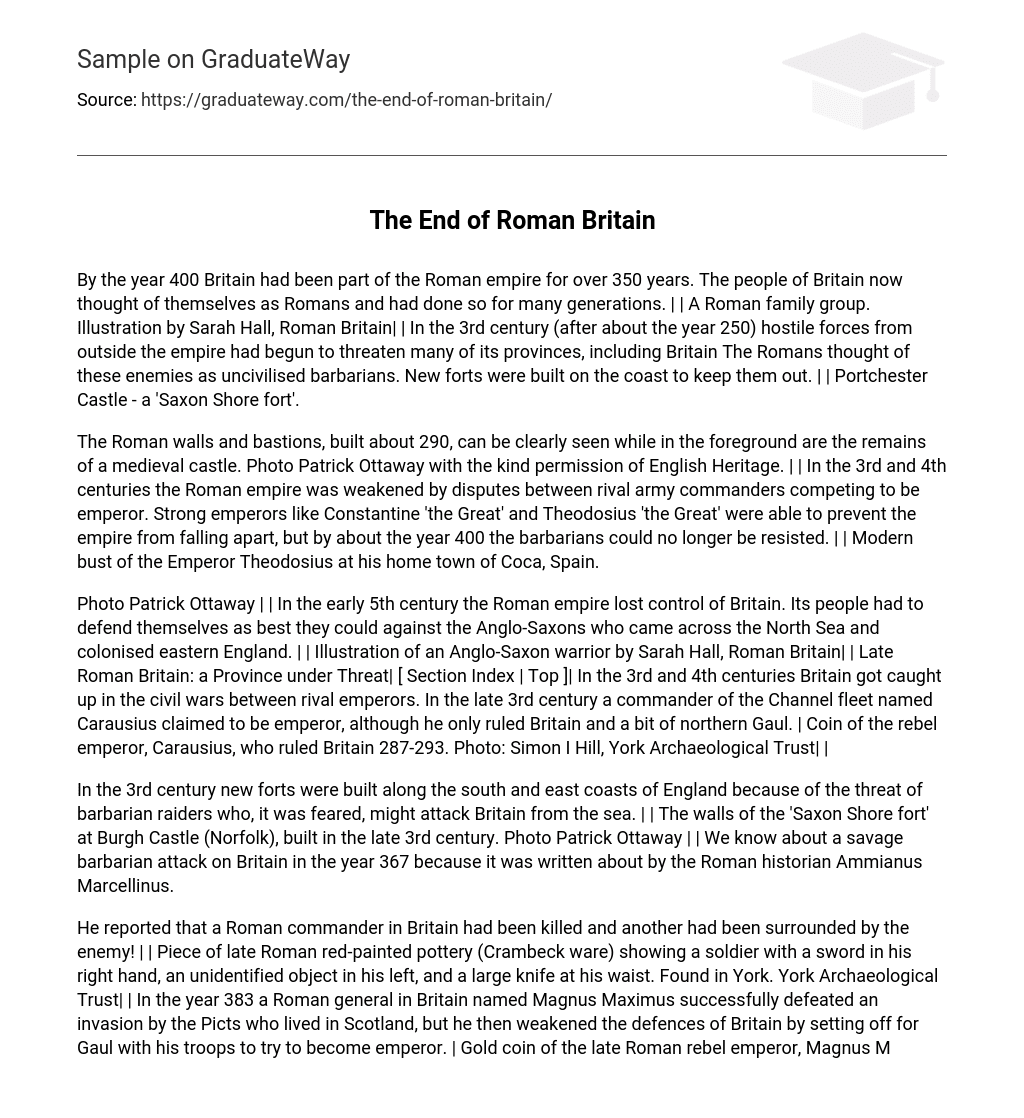By the year 400 Britain had been part of the Roman empire for over 350 years. The people of Britain now thought of themselves as Romans and had done so for many generations. | | A Roman family group. Illustration by Sarah Hall, Roman Britain| | In the 3rd century (after about the year 250) hostile forces from outside the empire had begun to threaten many of its provinces, including Britain The Romans thought of these enemies as uncivilised barbarians. New forts were built on the coast to keep them out. | | Portchester Castle – a ‘Saxon Shore fort’.
The Roman walls and bastions, built about 290, can be clearly seen while in the foreground are the remains of a medieval castle. Photo Patrick Ottaway with the kind permission of English Heritage. | | In the 3rd and 4th centuries the Roman empire was weakened by disputes between rival army commanders competing to be emperor. Strong emperors like Constantine ‘the Great’ and Theodosius ‘the Great’ were able to prevent the empire from falling apart, but by about the year 400 the barbarians could no longer be resisted. | | Modern bust of the Emperor Theodosius at his home town of Coca, Spain.
Photo Patrick Ottaway | | In the early 5th century the Roman empire lost control of Britain. Its people had to defend themselves as best they could against the Anglo-Saxons who came across the North Sea and colonised eastern England. | | Illustration of an Anglo-Saxon warrior by Sarah Hall, Roman Britain| | Late Roman Britain: a Province under Threat| [ Section Index | Top ]| In the 3rd and 4th centuries Britain got caught up in the civil wars between rival emperors. In the late 3rd century a commander of the Channel fleet named Carausius claimed to be emperor, although he only ruled Britain and a bit of northern Gaul. | Coin of the rebel emperor, Carausius, who ruled Britain 287-293. Photo: Simon I Hill, York Archaeological Trust| |
In the 3rd century new forts were built along the south and east coasts of England because of the threat of barbarian raiders who, it was feared, might attack Britain from the sea. | | The walls of the ‘Saxon Shore fort’ at Burgh Castle (Norfolk), built in the late 3rd century. Photo Patrick Ottaway | | We know about a savage barbarian attack on Britain in the year 367 because it was written about by the Roman historian Ammianus Marcellinus.
He reported that a Roman commander in Britain had been killed and another had been surrounded by the enemy! | | Piece of late Roman red-painted pottery (Crambeck ware) showing a soldier with a sword in his right hand, an unidentified object in his left, and a large knife at his waist. Found in York. York Archaeological Trust| | In the year 383 a Roman general in Britain named Magnus Maximus successfully defeated an invasion by the Picts who lived in Scotland, but he then weakened the defences of Britain by setting off for Gaul with his troops to try to become emperor. | Gold coin of the late Roman rebel emperor, Magnus Maximus (383-8). | | Did you know? The term ‘barbarian’ comes from a Greek word. The Greeks thought that Greek was the only civilised language and that everyone else just said ‘bar bar bar’! | | Detail of a cavalryman’s tombstone at Ribchester (Lancashire) showing a dying barbarian. Photo Simon I. Hill, Ribchester Museum Trust| |





